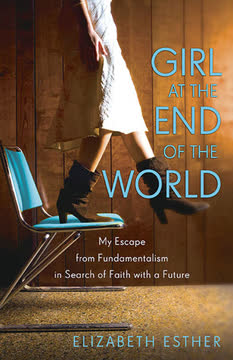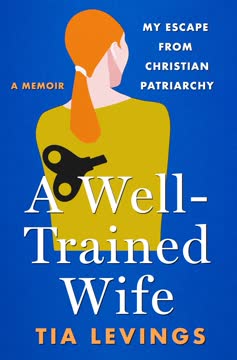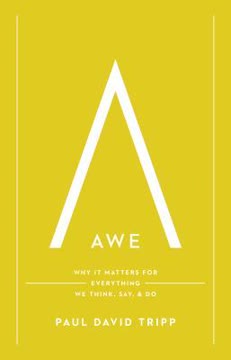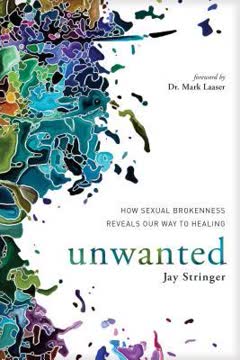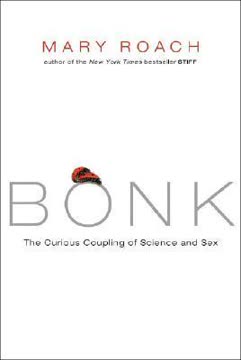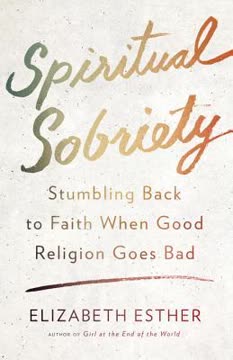Key Takeaways
1. Fear-Based Fundamentalism Shapes a Child's World
Indeed, everything in our lives was oriented toward the End of the World.
Apocalypse preparation. Elizabeth's childhood in "The Assembly," a fundamentalist Christian group founded by her grandfather, George Geftakys, was dominated by the imminent threat of the End of the World. This meant constant readiness for the Rapture or the Antichrist's takeover, influencing every aspect of life from finances to daily routines. Her parents, believing the future was irrelevant, never saved for college or retirement, instilling in Elizabeth a resignation to die for Jesus by age nine.
Fear as motivation. The Assembly's theology used fear to ensure conformity and spiritual zeal. Elizabeth was taught to street-preach from a young age, believing that enduring persecution would earn her "heavenly swag." The constant emphasis on sin, judgment, and the need for repentance led her to repeatedly "ask Jesus into her heart," driven by a desperate need for reassurance and a fear of being "Left Behind."
Psychological impact. This fear-driven environment had profound psychological effects. After a Christian horror film about the Rapture, Elizabeth developed night terrors, chronic stomach pain, and anxiety attacks, often hiding in fear of the Antichrist. Her parents, however, dismissed these symptoms as "melodrama" or "allergies," as mental illness was seen as a sign of weak faith, further isolating her in her distress.
2. Cultish Control Destroys Personal Freedom
Cults aren’t so much about beliefs as they are about methods and behavior.
Total control. The Assembly operated like a cult, exerting total control over its members' lives, not just their beliefs. This included communal living in "training homes" where privacy was nonexistent, schedules were rigid, and every action, from chores to tone of voice, was monitored. The goal was "unity in Christ," achieved through absolute loyalty to Papa George, who was self-ordained and answered to no one.
Breaking the will. A core tenet of The Assembly was "child-training," which involved spanking children from six months old to break their will and ensure "first-time obedience." Elizabeth's mother used a wooden paddle inscribed with "The rod and reproof give wisdom," and spankings were administered coolly and methodically, often multiple times a day. This systematic punishment was justified as saving a child's soul from hell.
Suppression of individuality. Any deviation from the norm was seen as rebellion. Women were expected to be modest and submissive, their roles strictly defined. Elizabeth's attempts to express individuality or question authority were met with rebuke, reinforcing the idea that personal feelings and desires were "worldly" and sinful. This environment fostered a deep sense of shame and self-loathing, particularly regarding her body and emotions.
3. The Trauma of Religious Abuse Manifests Physically
My body was reacting as if it had a mind of its own.
Physical symptoms of trauma. The constant fear, control, and abuse Elizabeth experienced manifested as severe physical and emotional symptoms. From childhood, she suffered from night terrors, chronic stomach pain, and anxiety. As an adult, these escalated into full-blown panic attacks, hyperventilation, profuse sweating, and psoriasis, indicating a body constantly on high alert.
Disassociation as a coping mechanism. To endure the frequent spankings, Elizabeth developed a coping mechanism called "disassociation," mentally detaching herself from her body by focusing on tiny details in her surroundings. This ability to "disappear" into patterns on a bedspread allowed her to survive the pain but also disconnected her from her own feelings and reality.
Internalized shame and self-harm. The relentless criticism and the belief that her body was "vile flesh" led to deep internalized shame. This manifested in self-harm, such as carving crosses into her thighs with her wedding ring, as a way to distract from emotional pain. Her body became a source of disgust, and she struggled with body image issues despite being underweight.
4. The Struggle to Break Free from Indoctrination
For the first time in my life, I wonder whether I am following God’s calling on my life or my dad’s.
Early attempts at autonomy. Elizabeth's exposure to public high school, despite her father's evangelistic intentions, opened her eyes to a world beyond The Assembly. She excelled academically and in extracurriculars like the school newspaper and swim team, seeing these as a potential "escape plan" to college. However, her parents viewed these pursuits as "worldly" and forced her to resign from the newspaper, crushing her dreams of a scholarship.
Forbidden relationships. The attention from boys at school, a stark contrast to her sheltered upbringing, further complicated her internal struggle. While her father warned her against "One Thing," Elizabeth found herself drawn to the affection and validation, leading to secret relationships. These experiences, though fleeting, offered glimpses of emotional connection and personal desire that were suppressed within The Assembly.
The "Selfer's Prayer" and forced submission. Even after marriage, the control continued. When Elizabeth questioned the abuse within her family, she was forced to recite the "Selfer's Prayer," admitting her life was a "failure and a mess" and surrendering to her husband's leadership. This ritualistic breaking of her will reinforced her feeling of being trapped, leading to a profound realization that she would "never be free."
5. Motherhood Becomes the Catalyst for Change
Suddenly, I was no longer fighting for myself—I was fighting to save my children.
Breaking the cycle. The birth of her first daughter, Jewel, became Elizabeth's turning point. When her grandmother instructed her to "test" Jewel's obedience by tempting her with chocolate and then spank her, Elizabeth faced a profound choice. In that moment, holding her baby, she realized she could not inflict the same pain she had endured, choosing "life" and "freedom" for her child instead of perpetuating the cycle of abuse.
Confronting the truth. This pivotal moment empowered Elizabeth and Matt to actively seek the truth about The Assembly. They researched a website by former members, uncovering detailed accounts of abuse, financial misconduct, and affairs within the leadership, including her grandfather's. This research provided the evidence they needed to confront her grandparents and ultimately leave the church.
Prioritizing her children's well-being. Leaving The Assembly was a difficult and isolating decision, severing ties with her entire social and familial network. However, the motivation to protect her children from the same harmful environment was paramount. This commitment to her children's healthy development became the driving force behind her continued healing and the pursuit of a new, healthier life.
6. Navigating Life After Leaving a High-Demand Group
Adapting to life on the outside was thrilling and also completely disconcerting.
Disorientation and assimilation. After leaving The Assembly, Elizabeth and Matt faced the challenge of adapting to mainstream American culture. This included learning basic social norms, understanding pop culture (like Oprah and reality TV), and navigating a world without constant supervision or a rigid schedule. The sudden freedom felt both liberating and like a "cavernous vacuum."
The lingering "apocalypse mentality." Despite leaving, Elizabeth found that the frantic, fear-driven mindset of fundamentalism still lingered. She struggled with overcommitment, black-or-white thinking, and a constant sense of urgency, transferring her "apocalypse mentality" to the need for immediate self-reinvention. This highlighted that leaving the physical environment didn't automatically erase years of indoctrination.
Social awkwardness and boundary issues. Her upbringing had left her ill-equipped for normal social interactions. She struggled to make friends, often coming across as "desperate and needy" due to her lack of understanding of social cues and personal boundaries. Her attempts to connect often felt like "selling Jesus," mirroring her past role as an "Independent Distributor of Salvation."
7. Healing Requires Re-evaluating Faith and Self
I had left fundamentalism, but fundamentalism hasn’t left me.
Therapy as a path to healing. Elizabeth eventually sought therapy, recognizing that her body's reactions (panic attacks, flashbacks) were beyond her control and that her past was still deeply affecting her present. Her therapist, Rae, helped her understand concepts like "disassociation" and "triggers," validating her experiences and teaching her to "be present" rather than numbing out.
Reclaiming emotional well-being. Therapy taught Elizabeth to identify and express her feelings, moving beyond the fundamentalist binary of "rejoicing or not rejoicing." She learned that sadness and anger were acceptable responses to her past trauma. This process of self-compassion and gentle self-care gradually reduced her anxiety attacks and improved her overall mental health.
Re-evaluating her relationship with God. The Bible, once a source of comfort, had become an "anxiety trigger" due to her grandfather's pervasive interpretation. She struggled to read it without hearing his voice, leading her to question if her faith was "doomed." This forced her to seek God in new ways, challenging Him to pursue her outside the confines of her fundamentalist upbringing.
8. Finding Grace and Forgiveness in a New Spiritual Path
If you can’t find Jesus, look for His mother.
A new spiritual connection. During a crisis in the NICU with her premature twins, Elizabeth experienced a profound sense of comfort and kinship with Mary, the Mother of God. This moment, a "spiritual safety" she had never felt before, challenged her fundamentalist upbringing that had neglected Mary and focused solely on male figures of faith. She began to see Mary as a mediator intimately acquainted with female suffering.
Embracing Catholicism. Drawn by this experience and the peace she felt in a Catholic church, Elizabeth began attending Mass. Despite her husband's initial skepticism and her own ingrained fundamentalist prejudices (e.g., the "garish" crucifix, "idolatry" of Mary), she found solace in the rituals, the reverence for mystery, and the unadorned reading of Scripture. She realized Catholicism offered a "room to breathe" that fundamentalism never did.
Learning to let go and trust. Her priest encouraged her to stop trying to "convert" her husband to Catholicism, reminding her that her journey was her own and that it was the Holy Spirit's job to convince. This lesson in letting go of control and trusting God's process was a significant step in her healing, allowing her to embrace her faith without the burden of responsibility for others' beliefs.
9. Recovery is an Ongoing Journey of Choice and Self-Compassion
I don’t believe in perfect closure. But each day, I can choose to take care of myself.
Active participation in healing. Elizabeth acknowledges that recovery is not a one-time event but a continuous, daily process. It involves actively untangling herself from the "fundamentalist inside me," which manifests as hyperalertness, guilt over rest, and black-or-white thinking. She learns to make conscious choices for her well-being, even if it means "taking a nap or giving herself a break."
Transforming pain into service. Blogging about her experiences with harmful child-training practices became a way for Elizabeth to transform her personal pain into service for others. This act of speaking out on behalf of endangered children provided a sense of purpose and contributed significantly to her healing from loss and regret.
Forgiveness and renewed relationships. The journey also involved confronting her parents and eventually receiving their apology for the pain they caused. While her relationship with them remains "rocky," they are learning to exercise boundaries and understand each other. Elizabeth's ability to forgive her grandparents and father, understanding their own damage, is a testament to her ongoing growth and commitment to grace.
Last updated:
Review Summary
Girl at the End of the World recounts Elizabeth Esther's escape from a fundamentalist cult. Reviews praise her bravery in sharing her story of spiritual abuse, with many readers finding it relatable and eye-opening. The book is described as well-written, compelling, and ultimately hopeful. Some criticize the quick resolution and transition to Catholicism. Readers appreciate Esther's honesty and humor despite the heavy subject matter. The memoir resonates with those who have experienced religious trauma, offering insight into cult dynamics and the journey to healing.
Girl at the End of the World Series
Similar Books
Download PDF
Download EPUB
.epub digital book format is ideal for reading ebooks on phones, tablets, and e-readers.
